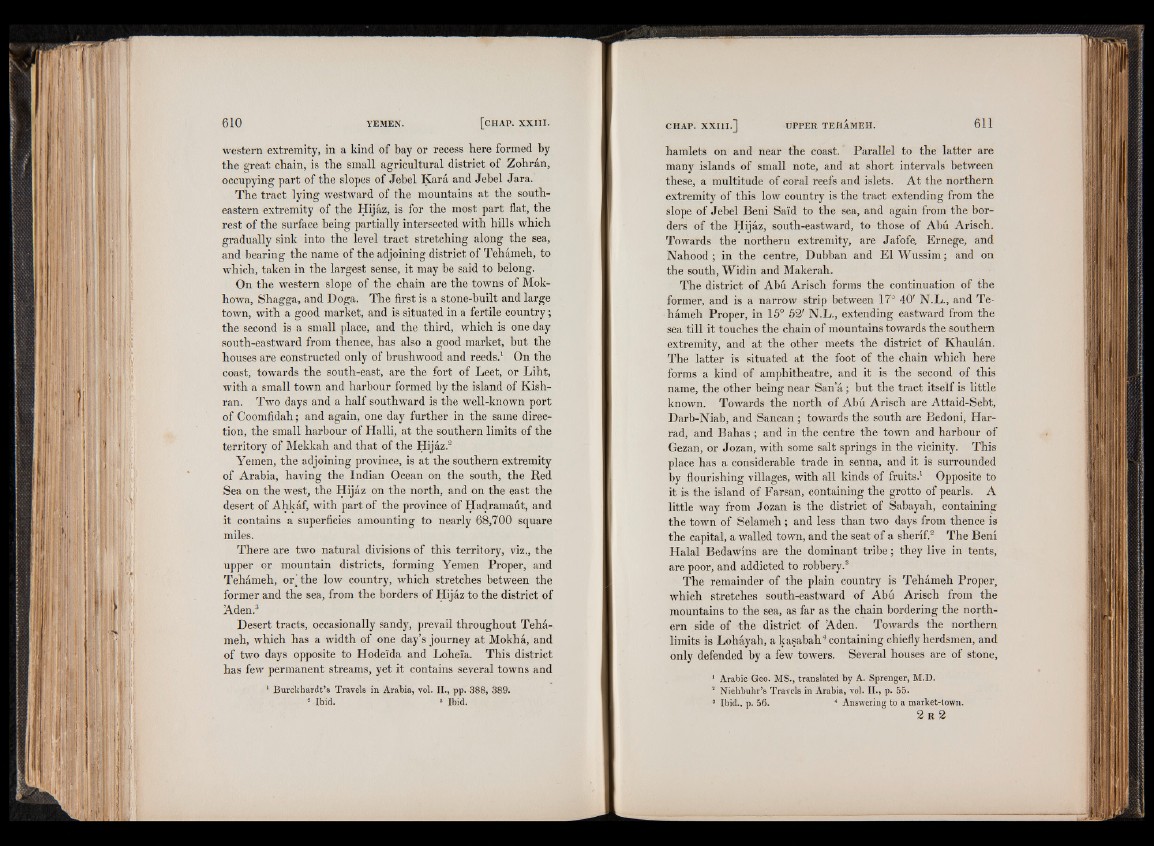
western extremity, in a kind of bay or recess here formed by
the great chain, is the small agricultural district of Zohran,
occupying part of the slopes of Jebel Kara and Jebel Jara.
The tract lying westward of the mountains at the southeastern
extremity of the Hijaz, is for the most part flat, the
rest of the surface being partially intersected with hills which
gradually sink into the level tract stretching along the sea,
and bearing the name of the adjoining district of Tehameh, to
which, taken in the largest sense, it may be said to belong.
On the western slope of the chain are the towns of Mok-
howa, Shagga, and Doga. The first is a stone-built and large
town, with a good market, and is situated in a fertile country;
the second is a small place, and the third, which is one day
south-eastward from thence, has also a good market, but the
houses are constructed only of brushwood and reeds.1 On the
coast, towards the south-east, are the fort of Leet, or Liht,
with a small town and harbour formed by the island of Kish-
ran. Two days and a half southward is the well-known port
of Coomfidah; and again, one day further in the same direction,
the small harbour of Halli, at the southern limits of the
territory of Mekkah and that of the Hijaz.2
Yemen, the adjoining province, is at the southern extremity
of Arabia, having the Indian Ocean on the south, the Red
Sea on the west, the Hijaz on the north, and on the east the
desert of Ahkaf, with part of the province of Hadramaut, and
it contains a superficies amounting to nearly 68,700 square
miles.
There are two natural divisions of this territory, viz., the
upper or mountain districts, forming Yemen Proper, and
Tehameh, oh the low country, which stretches between the
former and the sea, from the borders of Hijaz to the district of
Aden.3
Desert tracts, occasionally sandy, prevail throughout Tehameh,
which has a width of one day’s journey at Mokha, and
of two days opposite to Hode'ida and Loheia. This district
has few permanent streams, yet it contains several towns and
hamlets on and near the coast. Parallel to the latter are
many islands of small note, and at short intervals between
these, a multitude of coral reefs and islets. At the northern
extremity of this low country is the tract extending from the
slope of Jebel Beni Said to the sea, and again from the borders
of the Hijaz, south-eastward, to those of Abu Arisch.
Towards the northern extremity, are Jafofe, Ernege, and
Nahood; in the centre, Dubban and El Wussim; and on
the south, Widin and Makerah.
The district of Abu Arisch forms the continuation of the
former, and is a narrow strip between 17° 40' N.L., and Tehameh
Proper, in 15° 52' N.L., extending eastward from the
sea till it touches the chain of mountains towards the southern
extremity, and at the other meets the district of Khaulan.
The latter is situated at the foot of the chain which here
forms a kind of amphitheatre, and it is the second of this
name, the other being near Sana; but the tract itself is little
known. Towards the north of Abu Arisch are Attaid-Sebt,
Darb-Niab, and Sancan; towards the south are Bedoni, Har-
rad, and Bahas ; and in the centre the town and harbour of
Gezan, or Jozan, with some salt springs in the vicinity. This
place has a considerable trade in senna, and it is surrounded
by flourishing villages, with all kinds of fruits.1 Opposite to
it is the island of Farsan, containing the grotto of pearls. A
little way from Jozan is the district of Sabayah, containing
the town of Selameh; and less than two days from thence is
the capital, a walled town, and the seat of a sherif.2 The Beni
Halal Bedawins are the dominant tribe; they live in tents,
are poor, and addicted to robbery.3
The remainder of the plain country is Tehameh Proper,
which stretches south-eastward of Abu Arisch from the
mountains to the sea, as far as the chain bordering the northern
side of the district of Aden. Towards the northern
limits is Lohayah, a kasabah4 containing chiefly herdsmen, and
only defended by a few towers. Several houses are of stone,
1 Arabic Geo. MS., translated by A. Sprenger, M.D.
3 Nielibubr’s Travels in Arabia, vol. II., p. 55.
3 Ibid., p. 56. * Answering to a market-town.
2 r 2